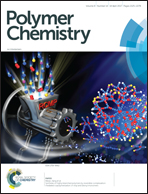Facile synthesis and chiral recognition of block and star copolymers containing stereoregular helical poly(phenyl isocyanide) and polyethylene glycol blocks†
Abstract
A new Pd(II) initiator bearing an alkyne headgroup was designed and synthesized. Living polymerization of phenyl isocyanide using this Pd(II) initiator afforded well-defined alkyne-terminated helical poly(phenyl isocyanide) (PPI) with controlled molecular weights (Mns) and narrow molecular weight distributions (Mw/Mns). The alkyne end group of PPI coupled with azide-terminated random-coil poly(ethylene glycol) (PEG) via copper-catalyzed alkyne–azide cycloaddition (CuAAC) “click” chemistry formed a novel class of helix–coil block copolymer PPI-b-PEG. The alkyne-terminated PPI coupled with a PEG bearing azides on both the two chain ends afforded a helix–coil–helix triblock copolymer PPI-b-PEG-b-PPI. When optically active alkyne-terminated PPIs bearing L- or D-menthol ester pendants were used in the coupling reaction, optically active di- and triblock copolymers were facilely achieved, which exhibited an intense Cotton effect on circular dichroism (CD) spectra due to the one-handed helical conformation of the PPI segments. Moreover, a Pd(II) complex bearing two alkyne headgroups was designed and synthesized, which initiated the living polymerization of phenyl isocyanide that lead to the formation of well-defined PPI with two alkyne groups on the same chain end. Coupling this helical polymer with azide-terminated PEG via CuAAC “click” chemistry formed a helix–(coil)2 miktoarm star copolymer containing two random-coil PEG segments and one helical PPI block. The amphiphilic block and star polymers containing hydrophobic PPI and hydrophilic PEG segments were found to self-assemble into well-defined spherical nanoparticles in water. Interestingly, these supramolecular architectures showed excellent chiral recognition to dansyl modified L- and D-phenylalanine (L- or D-Phe-DNSP) in high enantiomeric selectivity.



 Please wait while we load your content...
Please wait while we load your content...